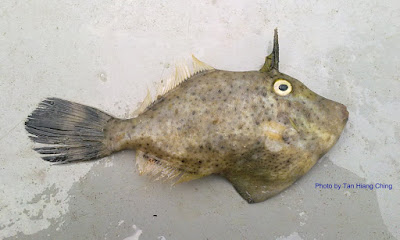Filefishes
Overview
Filefishes or leatherjackets are members of the Monacanthidae family. They are found in the Atlantic, Indian and Pacific oceans. They inhabit shallow coral and rocky reefs, seagrass beds, and trawling grounds in depths of 10 to over 200 meters. They are recognized by their first dorsal fin that consists of a prominent spine which can be locked upright by a second very small spine. Their body are usually deep and highly compressed, covered with scales armed with 1 to many fine spinules, giving a feel of leather or file (hand tool).Filefishes are typically found at depths ranging from 0 to about 170 meters. They are primarily bottom-dwellers, inhabiting coral and rocky reefs, as well as sand and mud bottoms, and seagrass beds. Their diet consists of a diverse array of bottom-dwelling invertebrates, such as sponges, and occasionally includes algae and plant matter. Filefishes have small mouths equipped with moderately-sized nipping teeth suited for their varied diet. Some species are schooling, but most are found as individuals or in pairs.
There are 28 genera and about 110 species of Monacanthidae worldwide.
Common Filefishes Species List
English Name: Unicorn Leatherjacket, Unicorn Filefish
Chinese Name | 鱼类中文名: 鹿仔鱼 (Lùzǐyú), 鸡鱼 (Jī yú), 肉竹 (Ròu zhú)
Malay Name | Nama Melayu Malaysia: Ikan Barat-barat, Kerosok Padi, Ayam Laut
Thai Name | ชื่อสามัญภาษาไทย: ปลาวัวหนัง (Plā wạw h̄nạng), ปลางัวใหญ่หางตัด (Plā ngạw yai h̄āng tạd), ปลาแรด (Plā ræd)
Local Hokkien: Keh Hu, Bak Teik
Main Identification Features: Skin leathery without fleshy appendages. Snout and throat both convex. First dorsal fin originates over the eye. Pelvic fin absent and without any obvious enlarged encasing scales. Caudal peduncle long. Caudal fin relatively short, 18 to 26% standard length.
Size: Maximum total length about 76 cm, commonly to 40 cm.
Habitat and Ecology: Coral reefs and sandy flats, 1 to 80 m depth. Solitary or in pairs, occasionally in groups of five or six, may also form large schools. Feeds on benthic organisms.

English Name: Prickly Leatherjacket
Chinese Name | 鱼类中文名: 鹿仔鱼 (Lùzǐyú)
Malay Name | Nama Melayu Malaysia: Ikan Bagang, Barat-barat Duri
Thai Name | ชื่อสามัญภาษาไทย: ปลาวัวหนามดอก (Plā wạw h̄nām dxk)
Local Hokkien: Thik Phuey, Keh Hu
Main Identification Features: Head and body with very large skin tentacles. First dorsal fin spine crooked in shape.
Size: Maximum total length about 32 cm.
Habitat and Ecology: Seagrasses and coastal reefs, to 45 m depth. Feeds on benthic organisms.

English Name: Fan-bellied Leatherjacket
Chinese Name | 鱼类中文名: 鹿仔鱼 (Lùzǐyú)
Malay Name | Nama Melayu Malaysia: Ikan Barat-barat, Barat-barat Kipas
Thai Name | ชื่อสามัญภาษาไทย: ปลาวัวหางพัด (Plā wạw h̄āng phạd)
Local Hokkien: Thik Phuey, Keh Hu
Main Identification Features: Posterior margin of ventral flap large, very convex in lateral profile. Snout upturned. Caudal peduncle with 3 pairs of spines, enlarged in adult. A filament extending from the top of the tail.
Size: Maximum total length about 40 cm.
Habitat and Ecology: Seagrasses and coastal reefs, 5 to 50 m depth. An omnivore which feeds mainly on seagrass, algae, gammarid amphipods and caridean shrimps as well as on bryozoans, hydroids, ascidians, copepods, caprellid amphipods and tanaidaceans.

English Name: Strap-weed Filefish, Smallspotted Leatherjacket
Chinese Name | 鱼类中文名: 鹿仔鱼 (Lùzǐyú)
Malay Name | Nama Melayu Malaysia: Ikan Barat-barat, Kerosok Rumpair
Thai Name | ชื่อสามัญภาษาไทย: ปลาวัวจุด (Plā wạw cud)
Local Hokkien: Thik Phuey, Keh Hu
Main Identification Features: Body with small weedy spots. Ventral flap very large. Gill opening anterior to eye. 3 unpaired spines on lower half of caudal peduncle.
Size: Maximum total length about 24 cm.
Habitat and Ecology: Estuaries and coastal weedy reefs, to 55 m depth. Occurs solitary or in pairs. Feeds mainly on zooplankton.
